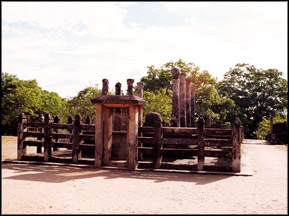|
Rising again to its former glory:
The amazing Polonnaruwa
By Chamari SENANAYAKE
|

‘Gal Viharaya’ built by King Parakramabahu contains four Buddha
statues
|
|

‘Vatadageya’ - An elaborate round building built of stone with
various decorations

‘Stone book’ which contains 4300 letters and weighs 25 tonnes is
a creation of King Nisshanka Malla. Itrecords his work and
times. |
Once a proud kingdom that had been nurtured by numerous great kings,
Polonnaruwa now stands a mere skeleton on the dry land of Rajarata.
Three years after uniting Sri Lanka defeating Chola invaders, King
Vijayabahu chose Polonnaruwa as his kingdom. Situated in a safe location
and protected by the rivers this area was once so prosperous that it
turned Sri Lanka into a major exporter of rice to the world in ancient
times.
Although it survived centuries of South Indian invasions, political
shifts and many other internal struggles, during the times of weak kings
and their unwise management, Polonnaruwa started to crumble and, the
once great kingdom was completely destroyed during Kalinga-magha
invasions and vanished under the trees and dust as a forgotten bookmark
in a history book.Almost a thousand years later on, the city was brought
back from the dead by the Archaeological Department during the British
colonial era. Rising again in its former places but with diminished
glory, Polonnaruwa screams of nothing else but grandeur and greatness.
Today it is one of the World Heritage Sites and is visited by thousands
of pilgrims and tourists from all over the world each month.
Just as our ancient kings struggled to keep South Indian invaders
away, there are many monks who live in nearby ancient and small temples
that struggled to stay alive from the LTTE terrorists for three decades.
They have been living in these lonely harsh places isolated from the
community but guarding the ruins and temples as if they were the great
stone masons that built them. Not a house nearby but the woods, let
alone a village, and no well could be dug as the rocks appear at every
corner and at every depth. Some have to walk a few miles to the village
in search of alms, and bring water from a river or a tank as some have
no wells or pipelines.
Even the animals that live with the monks have to walk long distances
in search of a drop of water. Some of the dog packs that hang around the
ruins will gladly show the pilgrims the way to the ruins and drop them
back to the buses just for a little bite or a biscuit. By visiting this
great city, a pilgrim shall not only gain good deeds, a tourist shall
not only get some scenic shots, by visiting the majestic city we once
had and the glory we have lost you will be doing the government a
service.

‘Rankoth Vehera’ |

Sathmahal Paya’- seven- story building that has a staircase
onthe left. |

‘Atadageya’ |

‘Hetadageya’ built by King Nisshanka Malla once housed the
tooth relic. |

‘Nisshanka Latha Mandapa’ |

‘Thuparamaya’- A house built for the statues, |
|
The writer holds B.A.(Australia), Grad. Cert.(Melbourne Uni),
M.A.(Australia)
|

